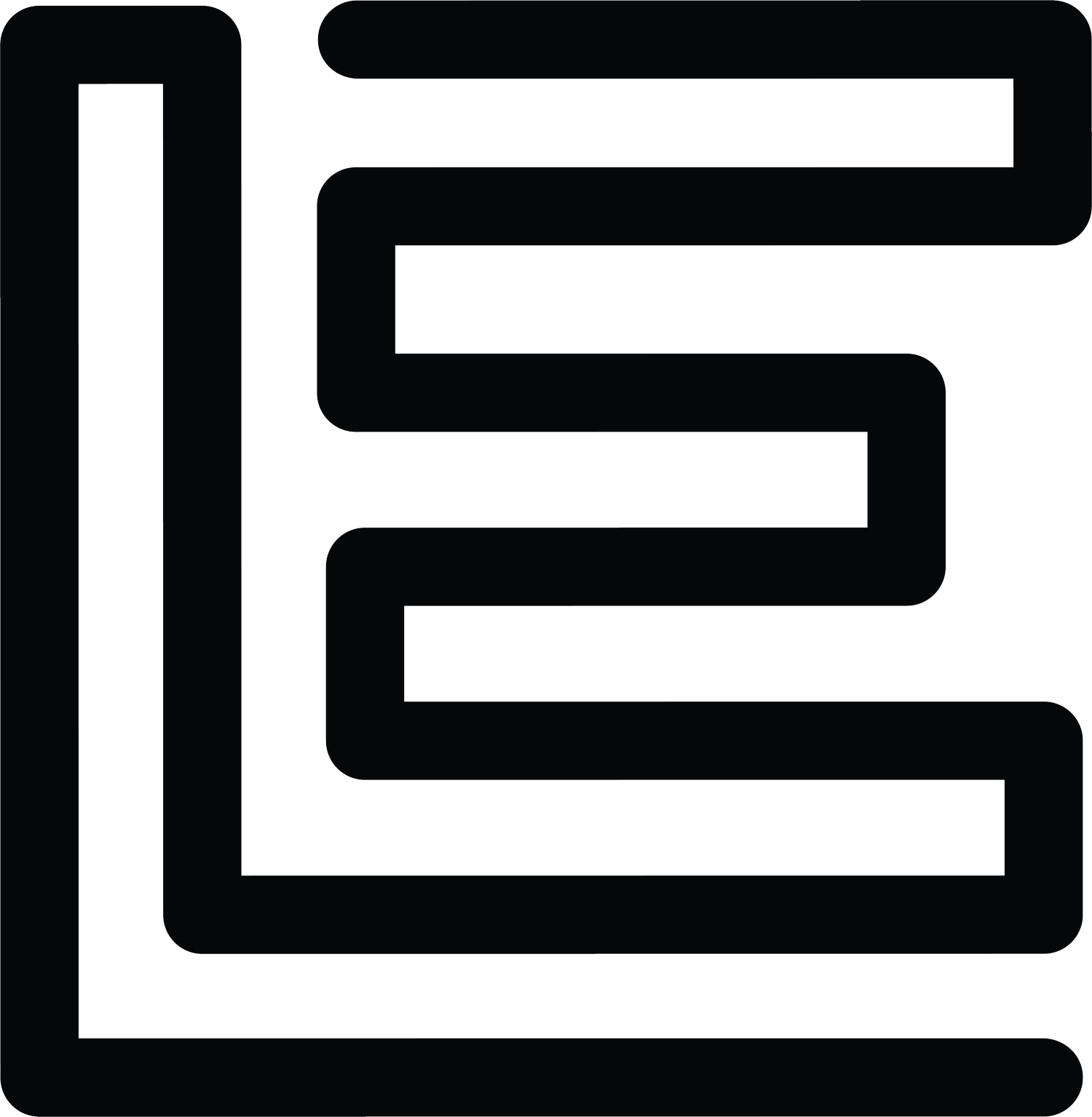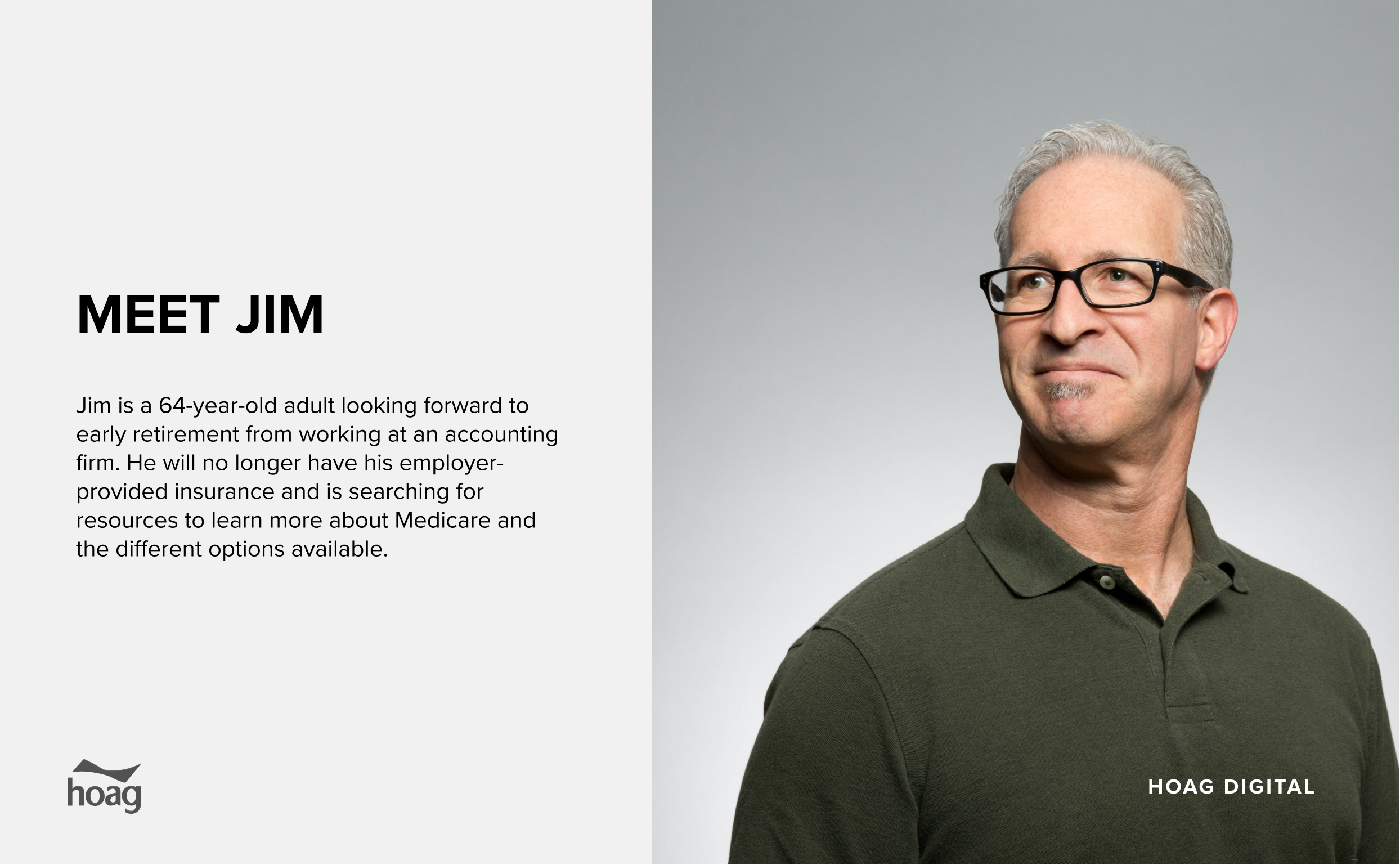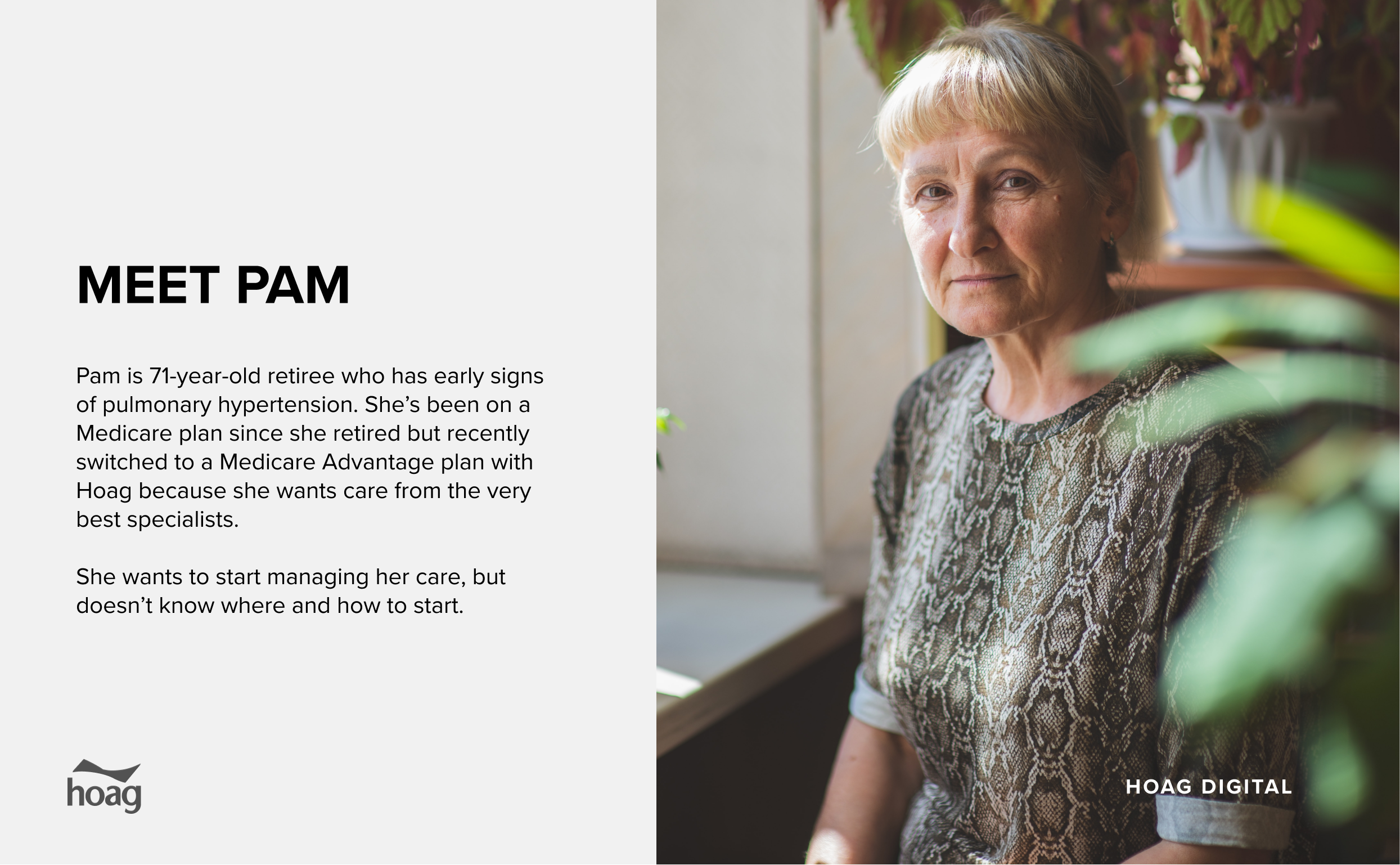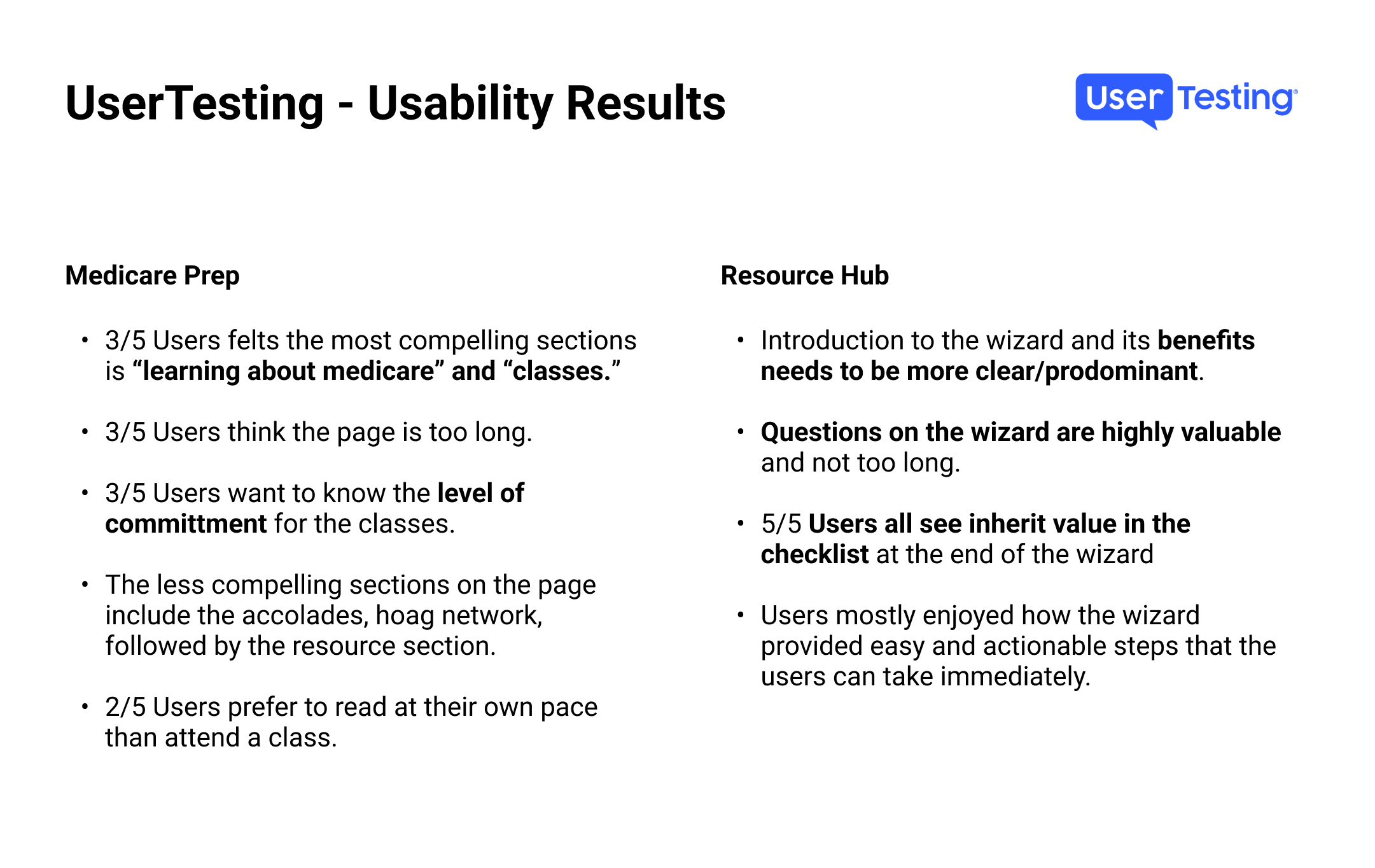Hoag Hospital Senior Care
Older adults face difficulties in accessing important Medicare health information and benefits, especially before they retire.
The Goal
My goal as a UX Designer is to help the clinic team digitalize resources for seniors, increasing their awareness of online services. This will make the hospital a thought leader, guiding seniors to the Medicare Advantage Plan and boosting preventative healthcare appointments with Hoag Medical Group.
The Results
Hoag’s better online promotion of their senior medicare classes resulted in a 6% rise in website visitors. They made the website easy for older adults to use and access and handle their medicare benefits with a digital checklist and professional guidance. They also supplied online and at-home resources for extra care.

How can we help seniors overcome struggles with technology and better access to Medicare benefits?
The Challenge
Business Problem
Caring for the elderly needs specialized training on dementia, safety, polypharmacy, and chronic complications. Current primary care lacks prevention, resulting in unsatisfactory outcomes for seniors. Overcoming negative perceptions of end-of-life care is crucial for a balanced approach to treatment and quality-of-life services.
Customer Problem
We need better models to address the health needs and diverse lifestyles of older patients, especially those with serious illnesses. The current business model doesn't consider the specific conditions of the elderly or the diversity of the population, instead focusing too much on younger middle-aged users.
The elderly are living longer thanks to better healthcare and conditions. In Southern California, over 20% of the population is now over 65 and this is set to rise.
According to Rock Health, studies have shown 50% of elderly are planning to “age in place”—furthering the adoption of all digital and at-home services.

The Research
The digital team sought insight on tech issues for seniors. The team conducted inclusive workshops with experts to understand the unique challenges faced by the elderly. An empathy map exercise was used to guide and gather key insights.
A short research sprint was conducted for both primary and secondary research sources to further grasp the current market. This further grounded the team in validating several key assumptions and quickly moving toward solutions.
An exploration surrounding the top geriatric programs currently available in the healthcare ecosystem was conducted to better understand our top competitors. This helped marketing in readjusting its key brand messaging for its own hospital in Orange County.
Demographic Exploration
-
“I think being at home is the most important thing.”
— Survey Candidate 3
-
“I don’t want to have to switch later. Why wait until I’m frail? I’d rather have someone who will know me a long time.”
— Survey Candidate 21
-
“Many people must continue to tend to their jobs, children, and other responsibilities while trying to help an older parent.”
— Survey Candidate 13
-
”It’s important to ask what is really important to them and really listen.”
— Provider Candidate 6
Key Demographic with Two Paths
Entering into retirement can be a thrilling but also confusing time for seniors. In order to improve the process, two path were created to better illustrate the customer journey. Seniors either searching for Medicare information or have recently signed up and want to take advantage of their benefits.
Research Data & Analysis
The research collected from surveys and user testing clarifies the major roadblocks found within the senior archetype demographic. Many of the problems can be improved with digital solutions and drove the design team to present a list of user experience recommendations. The client moved forward with three initiatives.
Welcome Questionnaire
Medicare Information Page
Senior Resource
Research Pillars
Autonomy & Personalization
Participants appeared generally willing to sacrifice a portion of their privacy as a trade-off for the benefit of safety and independent living, provided they could retain a sufficient degree of autonomy.
Familiar Environment with a strong support system
Providing a familiar space for the elderly to feel “at home” and connected to their community. Caregivers, daycare, schools, and pet care can all help with the feeling of social isolation.
Building Long-Term Trust with Primary Care Physicians
According to our survey, elderly patients often rely on long-time (PCP) Primary Care Physicians for recommendations and services.
Early adoption for advancing machine learning and data collection
Early adoption helps with technological acceptance in later age. The sooner we can set up an EHR database, the more we can learn and cater to individual needs.
Resources & Education
Understanding your options for end-of-life services can be confusing and fragmented. More education is needed for accessibility, caregiving, and insurance limitations.
Caregiver Support Needs Improvements
The lack of submissions from caregivers indicates they don’t know what their family member needs for geriatrics.


Senior Resource Hub & Welcome Wizard
Since users have already selected Medicare Advantage and Hoag as their providers—users are looking for additional guidance from their provider on what actionable steps to take next. They look to further understand what benefits they can get from either Medicare or Medicare Advantage Plan (MA).
The goal is to feel connected and comfortable with Hoag and their physicians as their healthcare providers. And to provide resources and tools for patients to be successful in their healthcare journey.
Medicare Preparations
The digital team was tasked with creating a central place where users can “Get Started.” In addition to providing context and resources about programs, services, and classes by Hoag.
Key Features Include:
“Get Started” Call to Action
Program, services, and classes
Understanding the Hoag Network
Speaking to a Personal Service Team
Contact Form
Project Retrospective
Organization & Patient Impact
With the development of a digital checklist and online class promotions to Medicare benefits, the hospital was only able to increase healthcare appointments by 6% as many seniors still struggle with technology and awareness. They also supplied online and at-home resources for extra care and was able to better assist senior who needed support for senior transition to retirement.
Ongoing Challenges
Working with seniors in a digital space is challenging for the same reasons adopting a habit takes time to learn into practice. The digital team would need to consider alternative forms of engagement through service design and even print to reach a wider audience of elders who need help.
What’s Next?
As the clinic team continues to collect data and learn more about senior needs–the hospital can begin to personalize experiences based on patient conditions, preferences, and needs.
Further exploration would be needed to consider compliance with accessibility needs for seniors who have difficulty using online because of visual impairments or other aging complications. The clinic team will continue to work with the digital team to collect feedback and data in order to fill in more senior content within the resource homepage.












